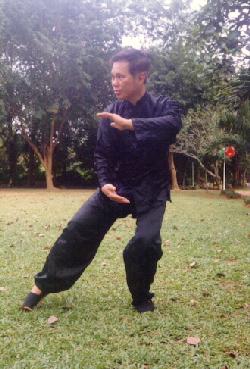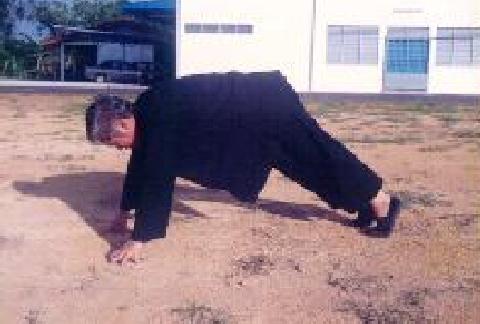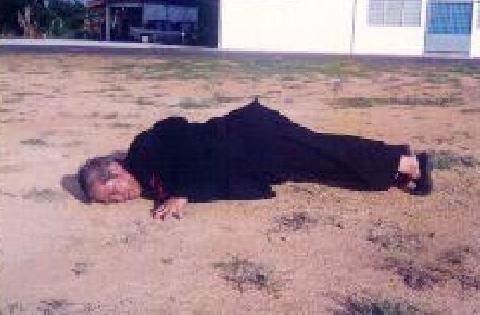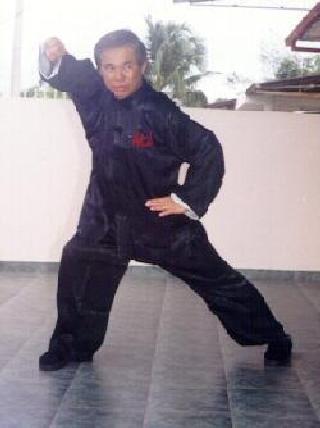May 2001 (Part 2)
SELECTION OF QUESTIONS AND ANSWERS

Sifu Wong demonstrating a pattern in Taijiquan. When practised as past masterrs did, any set of Taijiquan irrespective of its styles is a set of chi kung as well, because every movement involves the training of energy and mind.
Question 1
I would just like to thank you for such a wonderful web page. I have no medical problems other than a mild curvature of my spine though it does not bother me and has not affected my flexibility. I have begun doing the horse stance to increase the time I can stand and I am also stretching regularly.
— Jerit, USA
Answer
Thank you for your kind words.
Although your spine does not give you much problem, it is better to overcome the slight defect, and then further strengthen it.
Your spine is your backbone, which figuratively means it greatly influences how well you can perform and how much you can approach your full potential. Your spine not only holds you up structurally, but also houses your central nervous system which control your physical movements, physiological functions as well as intellectual activities.
Ideally you should come to my Intensive Chi Kung Course which will be excellent for your spine, but in practical terms this is not necessary. As your case is not serious, you can practise “Lifting the Sky” and “Carrying the Moon” from my books, and you can achieve good results. Just do the two exercises as I have described in my books; don't add anything — in action or in thought — on your own. For example, if I say “breathe in gently”, just do that. Do not breathe in gently and think of chi flowing to the curvature of your spine — this is adding something extra.
You may continue your Horse-Riding Stance and stretching exercise, but give priority to “Lifting the Sky” and “Carrying the Moon”. For example, if you have time for doing only one exercise, then practise either “Lifting the Sky” or “Carrying the Moon”, rather than Horse-Riding Stance or stretching.
Question 2
I've also just recently ordered three of your books, “Introduction to Shaolin Kungfu”, “Chi Kung for Health and Vitality”, and “The Art of Shaolin Kung Fu”. Are there any exercise in your professional opinion I should concentrate on? My hope is to be relatively well prepared for receiving formal instruction. One day I would like to receive training from you personally.
Answer
Concentrate on “Lifting the Sky” and “Carrying the Moon”. They are two of the best exercises in all chi kung. Besides straightening and strengthening your spine, they give you many other benefits too, like getting you to be focused and relaxed, increasing your energy level, and making you fresh and agile.
When you have overcome your spine problem, which may take about a year working on your own (the recovery would be faster if you have attended my Intensive Chi Kung Course), you can use “Introduction to Shaolin Kungfu” or “The Art of Shaolin Kung Fu” as the basic of your training.
Meanwhile you should learn some kungfu or wushu form from a local instructor. You will probably learn only the external forms, as today it is very difficult to find teachers who can teach you internal force and genuine kungfu sparring. But that is alright, because your ad hoc objective is to know some kungfu forms, even if they are performed as gymnastics or dance, so that when you come to my Intensive Kungfu Course later on, you do not have to waste time going over the preliminaries.
The methods you use learning on your own or from mediocre instructors will be different from those when learning from a genuine master. On your own your focus is on learning forms, whereas with a master it is on internal force and combat application. You can, and should, also spend time consistently on force training, but the methods chosen and the type of force developed would be quite different. You should focus on the more mobile and external type of force, like stretching and Thirty Punches.
On the other hand, a master would teach you more advanced and internal force like zhan zhuang and internal chi flow. But why can't you learn these more advanced methods on your own or from mediocre instructors. You can, and many people do, but you and these people are likely to hurt yourselves. It is not merely knowing the methods, but more significantly how you perform the methods, and without proper supervision it is likely you will perform the methods wrongly even though you follow the instructions correctly. One common mistake is that you would be tensed although you know you should be relaxed.
Question 3
If someone wanted to take one of your intensive training courses but was unable to make it to the one he wanted, would he be able to go to a different course and learn the stuff from it, or does he have to wait until you offer the course again? I was just curious since you are so busy and only offer these courses at certain times of the year.
Answer
He should wait until I offer the course again. For example, he may be interested in Shaolin Kungfu, but if he takes my Taijiquan course instead, he may get some benefits, but the course does not meet his needs and aspirations.
While the general aims of my three intensive courses are the same — good health, vitality, mental freshness and spiritual joy, and in the case of Shaolin Kungfu and Taijiquan, combat efficiency — the nature, approach and content are different. For those who are not interested in martial art, it is best to take my intensive chi kung course. It is the least demanding, even fun to do, and the benefits are wonderful.
Although taking my chi kung course first is an excellent introduction to my Taijiquan and Shaolin Kungfu courses, it is not necessary, because chi kung is an essential aspect in these two martial art courses, though the actual chi kung exercises are different. My Taijiquan course is very different from what most people think what a Tai Chi class is. Those who are not prepared to work hard should not attend my Shaolin Kungfu course.
In these two martial art courses, good forms in Taijiquan or Shaolin Kungfu are required, but little time is spent on learning forms during the courses. Hence, intending students should have learnt their forms well, before attending my courses. Most of the time will be spent on force training and combat application.


“Taming the Tiger” demonstrated by Sifu Wong. Usually this exercise is performed with the palms on the ground. At an advanced stage, the tiger-claws instead of the palms are used to support the body-weight.
Question 4
While I know that every monk would spend his day differently, what was a typical day routine for a Shaolin monk.
Answer
What I describe below was a typical day of a Shaolin monk in the past. I am not sure if there are real monks, i.e. those who have voluntarily renounced world life for spiritual cultivation, in the Shaolin Temple today.
There were four types of Shaolin monks: administrative, scholar, martial and service monks. Described below was a typical day of a Shaolin martial monk. Martial monks were considered the elite group of Shaolin monks.
At five in the morning he assembled with all other monks in the Temple Hall for “morning lessons.”. This was the most important part of his training, for which he voluntarily renounced worldly life to pursue. After paying homage to the Buddha, the Boddhisattvas and their living masters, the monks chanted Buddhist sutras, the most important of which was the Heart Sutra. This was the cultivation of blessings.
Then the abbot or one of the masters would give a sermon on a topic in the scriptures or on any relevant topics. Next the monks practised meditation, which was the most important part of a monk's training. This was the cultivation of wisdom. Cultivating blessings and cultivating wisdom are the two pillars of Mahayana Buddhism.
After the “morning lessons”, the monks had breakfast, which usually consisted of plain rice porridge. If they were lucky that day, a few salted nuts might be added. At eight in the morning, the various monks went about their respective work. The martial monks attended morning kungfu training.
At twelve noon the monks had their lunch, which was again plain rice porridge, occasionally with a few pieces of vegetable if they were lucky. After lunch the monks had some free time on their own. A martial monk might take the opportunity to practise kungfu on his own.
At three in the afternoon, the monks practised meditation, the essential path to enlightenment. At five o'clock the monks had dinner, the most “luxurious” meal, where rice was served with plain vegetable or bean curd. On festive days, two or three special vegetarian dishes would be served.
After resting for a while, martial monks had their evening kungfu training. At nine at night all monks assembled in the Temple Hall again for their “evening lessons”, where they paid homage to the Buddha, the Bodhisattvas, and their masters, chanted sutras, listened to sermons and practised meditation. After that they went to bed.
Question 5
I have all your books and I find them fascinating reading! I have practised Sinew Metamorphosis from your first Chi Kung book but had to stop because I started to get pains in my hands and arms. I was getting varicose veins. What was I doing wrong? Perhaps just my physiological makeup.
— Ivan, Australia
Answer
Sinew Metamorphosis, or Yi Jin Jing in Chinese, is an advanced art for internal force training. It is very powerful if trained correctly but incorrect training may bring serious adverse effects. Masters have always warned that advanced internal arts must only be practised with proper supervision.
Yours is a case of incorrect training, but you need not worry. It has not been serious yet; it is just a warning sign that something is wrong and you should stop your training. In kungfu training terms, your adverse effect is at the “muscle stage”, but if you fail to heel the warning it may develop into the “organ stage”, which can be serious.
In your case, should the adverse effect develop to the “organ stage”, your chest would likely be affected. Symptoms would be chest pain, and in a more serious condition, vomiting of blood.
The pain in your hands and arms is due to energy blockage. Such adverse effects are common among those who have practised the art wrongly. You have used too much strength in your practice, and probably have been tensed too. These are common mistakes made by those learning from books or videotapes. They know the instructions to be relaxed and not to use strength, but they make the mistakes nevertheless, without realizing it.
An effective way to overcome your adverse effect is to perform “Lifting the Sky”. Perform this chi kung exercise about 30 times per session, once in the morning and the other at night. (Note Shaolin Wahnam students need to perform only about 15 times per session.) Breathe in gently and breathe out gently, but with slightly more force than breathing in, but not forcedly. Then stand with your eyes gently close and let your chi massage your hands and arms.
Question 6
I also started to do the chi exercise in “Introduction to Shaolin Kung Fu” and developed some chi with my hands (tingling feeling), my left hand in particular. My left thumb and forefinger started to get very hard and then became quite painful. It felt as though something or the ends of my finger or thumb were to explode. Once again I stopped because it began to scare me. Can you please explain to me what was going on and should I persist?
Answer
Here you also have practised incorrectly, and this time the adverse effect is more serious. You must stop your self-taught training, otherwise the adverse effect may spread upwards your arms to your lungs and heart.
You were successful in developing internal force at your thumb and forefinger, but you failed to shoot out this internal force as in striking an opponent. Consequently you locked up the meridians in your arm. Your adverse effect can be overcome by practising “Lifting the Sky” as described above.

Sifu Wong demonstrating a Chen Style Taijiquan pattern called “Seven-Star Anchor”
Question 7
I have read Introduction to Shaolin Kung Fu, and understand the principle of lowering one's centre of gravity (for example the Horse stance). You also describe one could increase one's upper body strength by doing at least thirty push-ups daily (Taming the Tiger). Does this not change the centre of gravity at the Dan Tian to the chest? Also does this not constrict chi flow from the Dan Tian up the spine to one's hand or Bahui point?
Answer
“Taming the Tiger” looks like push-ups, but there are some crucial difference. If you perform push-ups as a physical exercise, you may have the adverse effects you mentioned above. But if you perform “Taming the Tiger” as a chi kung exercise, you can enhance your abdominal dan tian as well as chi flow up the spine and to your hands or bai-hui point.
The difference between performing it as a physical exercise and as a chi kung exercise cannot be easily described in words or pictures. That is one of many reasons why one should practise chi kung from a competent instructor who himself can perform chi kung. If you have performed chi kung, you would have no difficulty telling the difference.
As an analogy, if you have eaten oranges but never tangerines, you would not know the difference in taste between an orange and a tangerine. No amount of verbal or pictorial description could help you. But if you have eaten both, you can tell the difference easily, even individual oranges or individual tangerines have individual tastes — just as in their own category different physical exercises or chi kung exercises have different effects.
Question 8
Can one practise Shaolin Kung Fu, Taijiquan and Chi Kung together or must one only practise Kung Fu and Chi Kung but not Taijiquan or vice versa?
Answer
You can practise just only one, or any two, or all of them together, but you will probably get better results if you focus on one. When you practise genuine Shaolin Kungfu or genuine Taijiquan, you are also practising chi kung, which is a collective name for energy management. But the energy exercises in Shaolin Kungfu and in Taijiquan would be different from the energy exercises in most chi kung types.
Question 9
Also can one do Taming the Tiger and other Chi Kung exercises such as Nei Kung and your ten dynamic exercises from your second Chi Kung book while practising Taijiquan?
Answer
Yes, you can, if you perform them as physical exercises, which is likely the case when you do not learn from a competent instructor. So long as you do not overstrain yourself physically, it does not make much difference whether you perform one, some or all the exercises. In the end you will still be doing dance or gymnastics, albeit in different forms.
No, you cannot, if you perform them wrongly as chi kung exercise, which is also a likely alternative. In this case you would aggravate your adverse effects. Getting adverse effects from one chi kung exercise is bad enough, getting from many would make your problems complicated.
If you practise genuine Taijiquan, there is no need to learn any other exercise outside Taijiquan. It is amazing how many people, without consciously being disrespectful and usually without realizing it, regard themselves smarter than the very masters they wish to learn from. Taijiquan masters do not perform “Taming the Tiger” and other Chi Kung exercises such as my ten dynamic exercises, yet many people think they can improve the methodology of Taijiquan training by performing them.
Question 10
I am 32 years old. I have practised a little kung fu (Jing Wu) and now learning Chen Taijiquan.
While practising taijiquan sometimes my hand goes hard and I become frightful again because of the pain and pressure as mentioned above. It particularly happens when I think of nothing which I find great difficulty in doing but I will persist.
Answer
It is foolhardy of you to persist. Your hand becoming hard and painful is a clear warning that you have been dabbling in energy exercise wrongly. If you persist you may not only harm your hand, you may also have internal injuries with far-reaching consequences.
The hands of Taijiquan masters are soft and very powerful, not hard and painful. “Iron wrapped in cotton” is an expression often used to describe their arms and hands. If you want to learn Chen Taijiquan, or any other style of kungfu, learn it from a master. In terms of time or money spent, this is more cost-effective than dabbling on your own or learning from a mediocre instructor who only teaches you external forms.
